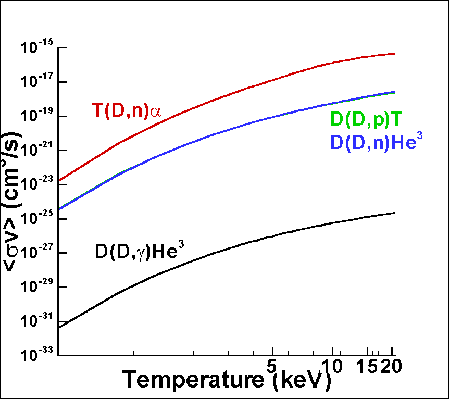D(D,gamma)4He
Do we get “enough” high energy gammas from the D(D, g)4He reaction (Q=23.85 MeV) in our experiments to see them using 12C activation in a cryo DD shot?
By Radha Bahukutumbi <rbah@lle.rochester.edu>
There has been some concern expressed by Craig Sangster, Steve Padalino and others that the relatively high cross-section of the 12C(g,n)11C reaction for gamma energies above 20 MeV, could prove to be a significant background for the tertiary neutron detection using 12C(n,2n)11C activation. One source of energetic gammas is from the D(D, g)4He reaction (Q=23.85 MeV). Since this is a DD reaction, there are two issues that one has to consider here, viz.,
- The ratio of high energy gammas (HEGs) to tertiary neutrons in DT targets.
- Can DD cryo-targets be used to develop the 12C activation method (CAM) using DD HEGs. This would allow for study of HEGs on the CAM in the absence of tertiary neutrons from cryogenic DT targets? (John Soures)
OMEGA cryogenic targets: The reaction rates for this reaction are shown below (black line). Also shown are the DT and DD reaction rates for comparison. For the temperature ranges of interest (approx. 1-5 keV) the D(D, g)4He reaction is suppressed by about 9 orders of magnitude relative to the DT reaction. For typical 1D areal densities (200 mg/cm2), the tertiary reaction is suppressed by 5×10-6 (above 20 MeV) relative to the primary yield. So for the cryogenic areal densities, tertiary neutrons are at least two orders of magnitude higher in yield compared to the gammas from the DD reaction. Therefore, I do not expect that this reaction can be a significant background to the detection of tertiary neutrons in OMEGA cryogenic targets.
Current DT experiments: For the current experiments (areal densities of about 10 mg/cm2), the tertiary reaction is suppressed by approximately 1×10-8 (above 20 MeV) relative to the primary yield. This is still an order of magnitude higher than the DD-gamma yield. The calculated tertiary yield on these shots (15109 for example) is of the order of 2×106. Using a YOC of 15% and assuming an experimental rR that is half of 1D-rR (8 mg/cm2), one can scale this to get the tertiary yield to be roughly 8×104. This corresponds to approximately 190 entering the carbon detector. Factor in the detector efficiency and cross section etc. (Bob Kremens’ memo of 1/25/97), this gives less than one activation in the disk
Current and future DD targets: As far as using DD targets to develop the detectors go, this reaction does not seem to be very useful. As the figure shows, this reaction rate is approximately 10-7 of the DD reaction rates. Therefore, if we can generate 1012 DD-neutrons then we can expect to see about 105 gammas, which translates to about 3 activations in the carbon disk.
Figure: Reaction rates for some DD and DT reactions.
Source: Caughlan and Fowler, Atomic and Nuclear Data Tables, 40, 283-334 (1988).

